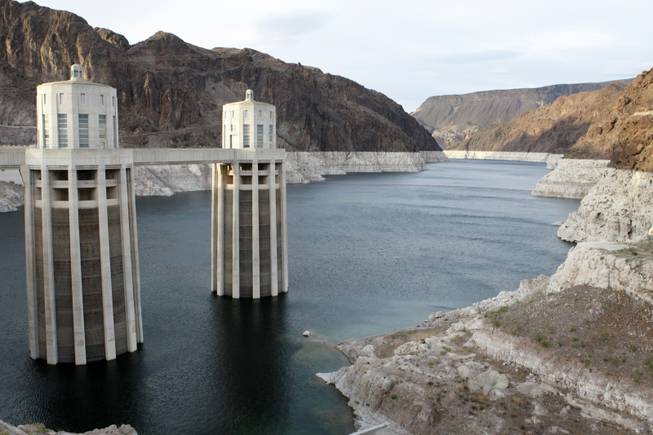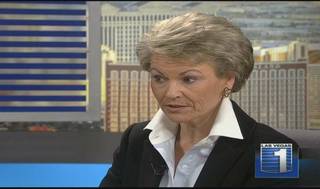
A view of low water levels at Hoover Dam on April 9, 2009. As demand increases for water in cities like Las Vegas, Phoenix and Los Angeles, climate change is projected to reduce available water in the Colorado River to produce periodic shortages, according to a new study.
Monday, April 20, 2009 | 3:48 p.m.
Sun Topics
Last Resort?

Viewing video requires the latest version of Adobe's Flash Player
As demand increases for water in cities like Las Vegas, Phoenix and Los Angeles, climate change is projected to reduce available water in the Colorado River to produce periodic shortages, according to a new study released today.
The Colorado River delivers water to 27 million people in seven western states and Mexico, but faces reduced runoff caused by increasing demands for water and warmer temperatures, which will create systematic shortages on the river, the latest study published by the Proceedings of the National Academy of Sciences says.
That means that scheduled deliveries will likely be missed 60 to 90 percent of the time by the middle of this century, said a pair of climate researchers at Scripps Institution of Oceanography at the University of California, San Diego.
"All water-use planning is based on the idea that the next 100 years will be like the last 100," said Scripps research marine physicist Tim Barnett, a co-author of the report. "We considered the question: Can the river deliver water at the levels currently scheduled if the climate changes as we expect it to. The answer is no."
Even under conservative climate change scenarios, Barnett and Scripps climate researcher David Pierce found that reductions in the runoff that feeds the Colorado could short the Southwest by 400,000 acre feet of water per year 40 percent of the time by 2025. (An acre foot of water is enough to meet the annual water needs of two households of four individuals each).
Instead, the study says that the the climate change occurring in a system conceived and allocated during the wettest period on the Colorado in the last 1,200 years has affected Lake Mead. Lake Mead has been over used by 1.3 million acre feet a year since 1999. After 1999 in the period that more demand and warmer temperatures led to the over use.
Earlier the same scientific team said that Lake Mead might go dry, or at least below the 1,000-foot level of the lowest intake to deliver water to Las Vegas, has a 50 percent chance by 2021.
However, the latest study has some good news in it. Although the demands on the river and the ongoing climate change could reduce the river by 20 percent, substantial shortages are manageable through a program of water reuse, conservation, transfers between users and other measures that the states and federal government will have to work out, the study says.

Join the Discussion:
Check this out for a full explanation of our conversion to the LiveFyre commenting system and instructions on how to sign up for an account.
Full comments policy